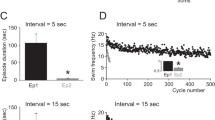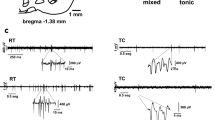Abstract
The neural network coordinating fictive locomotion in the isolated lamprey spinal cord can be activated by either N-methyl-D-aspartate (NMDA) or kainate/AMPA receptors. Serotonin (5-HT) is known to affect the pattern of fictive locomotion induced by NMDA receptor activation by increasing spike rate within a burst, increasing burst duration, and increasing the intersegmental delay. Two cellular mechanisms contribute to these 5-HT induced effects: The after-hyperpolarization following individual action potentials is reduced and the depolarizing plateau induced by NMDA is prolonged. Both of these serve as important burst-terminating factors in the locomotor network. In order to isolate these two mechanisms, the 5-HT effect on plateau potentials was eliminated by applying 5-HT during fictive locomotion induced by activation of kainate/AMPA receptors. In the absence of NMDA-mediated plateau potentials, the 5-HT-induced increase in burst duration and cycle period was greater than that previously reported during NMDA-induced fictive locomotion. In addition, the prolonged burst period of a single side was subdivided into brief multiple bursts with a shorter cycle period than the control reciprocal burst activity. Intracellular recordings of spinal neurons combined with chloride injection to reverse inhibitory post-synaptic potentials revealed that, in a proportion of these cells, the bursting within a single side may be generated solely or predominantely by phasic excitation.
Similar content being viewed by others
References
Berger AJ, Takahashi T (1990) Serotonin enhances a low-voltageactivated calcium current in rat spinal motoneurons. J Neurosci 10(6): 1922–1928
Brodin L, Grillner S (1985) The role of putative excitatory amino acid neurotransmitters in the initiation of locomotion in the lamprey spinal cord. I. The effects of excitatory amino acid antagonists. Brain Res 380:139–148
Brodin L, Grillner S (1986) Effects of magnesium on fictive locomotion induced by activation of N-methyl-d-aspartate (NMDA)receptors in the lamprey spinal cord in vitro. Brain Res 380:244–252
Brodin L, Grillner S, Rovainen CM (1985) N-methyl-d-aspartate (NMDA), kainate and quisqualate receptors and the generation of fictive locomotion in the lamprey spinal cord. Brain Res 325:302–306
Brodin L, Buchanan JT, Hokfelt T, Grillner S, Verhofstad AAJ (1986) A spinal projection of 5-hydroxytryptamine neurons in the lamprey brainstem; evidence from combined retrograde tracing and immunohistochemistry. Neurosci Lett 67:53–57
Brodin L, Traven H, Lansner A, Wallen P, Ekeberg O, Grillner S (1991) Computer simulations of N-methyl-d-aspartate receptorinduced membrane properties in a neuron model. J Neurophysiol 66:473–484
Buchanan J, Grillner S (1988) A new class of small inhibitory interneurons in the lamprey spinal cord. Brain Res 438:404–407
Buchanan J, Grillner S (1991) 5-Hydroxytryptamine depresses reticulospinal excitatory postsynaptic potentials in motoneurons of the lamprey. Neurosci Lett 112:71–74
Cazalets JR, Grillner P, Menard I, Cremieux J, Clarac F (1990) Two types of motor rhythm induced by NMDA and amines in an in vitro spinal cord preparation of neonatal rat. Neurosci Lett 111:116–121
Christenson J, Franck J, Grillner S (1989) Increase in endogenous 5-hydroxytryptamine levels modulate the central network underlying locomotion in the lamprey spinal cord. Neurosci Lett 100:188–192
Christenson J, Cullheim S, Grillner S, Hokfelt T (1990) 5-Hydroxytryptamine immunoreactive varicosities in the lamprey spinal cord have no synaptic specializations — an ultrastructural study. Brain Res 512:201–209
Grillner S, Matsushima T (1991) The neural network underlying locomotion in lamprey — synaptic and cellular mechanisms. Neuron 7:1–15
Grillner S, McClellan A, Sigvardt K, Wallen P, Wilen M (1981) Activation of NMDA receptors elicits “fictive locomotion” in lamprey spinal cord. Acta Physiol Scand 113:549–51
Grillner S, Buchanan JT, Lansner A (1988) Simulation of the segmental burst generating network for locomotion in lamprey. Neurosci Lett 89:31–35
Grillner S, Wallen P, Brodin L, Lansner A (1991) Neuronal network generating locomotor behaviour in lamprey: Circuitry, transmitters, membrane properties and simulation. Ann Rev Neurosci 14:169–199
Harris-Warrick RM, Cohen AH (1985) Serotonin modulates the central pattern generator for locomotion in the isolated lamprey spinal cord. J Exp Biol 116:27–46
Harris-Warrick RM, McPhee JC, Filler JA (1985) Distribution of serotonergic neurons and processes in the lamprey spinal cord. Neuroscience 14:1127–1140
Hernandez P, Elbert K, Droge MH (1991) Spontaneous and NMDA evoked motor rhythms in the neonatal mouse spinal cord: an in vitro study with comparisons to in situ activity. Exp Brain Res 85:66–74
Hill RH, Matsushima T, Schotland J, Grillner S (1992) Apamin blocks the slow AHP in the lamprey and delays termination of locomotor bursts. Neuroreport 3:943–945
Holohean AM, Hackman JC, Davidoff RA (1990) Changes in membrane potential of frog motoneurons induced by activation of serotonin receptor subtypes. Neuroscience 34(3): 555–564
Honma S (1970) Presence of monoaminergic neurons in the spinal cord and intestine of the lamprey. Arch Histol Jpn 32:383–393
Hounsgaard J, Kiehn O (1985) Ca2+ dependent bistability induced by serotonin in spinal motoneurons. Exp Brain Res 57:422–425
Hounsgaard J, Kiehn O (1989) Serotonin-induced bistability of turtle motoneurons caused by a nifedipine-sinsitive calcium plateau potential. J Physiol (Lond) 414:265–282
Jahnsen H, Llinas R (1984) Ionic basis for the electroresponsiveness and oscillatory properties of guinea-pig thalamic neurones in vitro. J Physiol (Lond) 349:227–247
Kahn JA (1982) Patterns of synaptic inhibition in motoneurons and interneurons during fictive swimming in the lamprey, as revealed by Cl- injections. J Comp Physiol 147:189–194
Matsushima T, Grillner S (1992) Local serotonergic modulation of calcium-dependent potassium channels controls intersegmental coordination in the lamprey spinal cord. J Neurophysiol 67:1683–1690
Matsushima T, Tegner J, Hill R, Grillner S (1992) GABAB-ergic modulation of the spinal locomotor network in lamprey I: Suppression of HVA Ca2+-channel and post-spike afterhyperpolarization. European Neuroscience Associations abstract
Ohta Y, Grillner S (1989) Monosynaptic excitatory amino acid transmission from the posterior rhombencephalic reticular nucleus to spinal neurons involved in the control of locomotion in lamprey. J Neurophysiol 62(5):1079–1089
Russell DF, Wallen P (1983) On the control of myotomal motoneurons during “fictive swimming” in the lamprey spinal cord in vitro. Acta Physiol Scand 117:161–170
Schotland JL (1992) Neural control of innate behaviour. In: Forssberg H, Hirschfeld H (eds) Children with movement disorders: motor control theories and therapeutic concepts. Karger, Basel, pp 159–168
Schotland JL, Matsushima T, Grillner S (1991) Effects of serotonin on NMDA, kainate, and sensory induced locomotor activity in the lamprey. Soc Neurosci Abstr 17 (1): 122
Schwindt PC, Spain WJ, Crill WE (1992) Calcium-dependent potassium currents in neurons from cat sensorimotor cortex. J Neurophysiol 67(1): 216–226
Sigvardt KA, Grillner S, Wallen P, van Dongen PAM (1985) Activation of NMDA receptors elicits fictive locomotion and bistable membrane properties in the lamprey spinal cord. Brain Res 336:390–395
Takahashi T, Berger AJ (1990) Direct excitation of rat spinal motoneurones by serotonin. J Physiol (Lond) 423:63–76
Van Dongen PAM, Hokfelt T, Grillner S, Verhofstad AAJ, Steinbusch HWM, Cuello AC, Terenius L (1985) Immunohistochemical demonstration of some putative neurotransmitters in the lamprey spinal cord and spinal ganglia: 5-hydroxytryptamine-, tachykinin-, and neuropeptide-Y-immunoreactive neurons and fibers. J Comp Neurol 234:501–522
Van Dongen PAM, Grillner S, Hokfelt T (1986) 5-Hydroxytryptamine (serotonin) causes a reduction in the after-hyperpolarization following the action potential in lamprey motoneurons and premotor interneurons. Brain Res 366:320–325
Viana Di Prisco G, Dubuc R, Wallen P, Grillner S (1992) 5-Hydroxytryptamine modulates spike frequency regulation in reticulospinal neurons involved in the control of locomotion in lamprey. Neurosci Lett 134:270–283
Wallen P, Grillner S (1987) N-Methyl-d-aspartate receptor-induced inherent oscillatory activity in neurons active during fictive locomotion in the lamprey. J Neurosci 7(9): 2745–2755
Wallen P, Buchanan JT, Grillner S, Hill RH, Christenson J, Hokfelt T (1989) Effects of 5-hydroxytryptamine on the after-hyperpolarization, spike frequency regulation, and oscillatory membrane properties in lamprey spinal cord neurons. J Neurophysiol 61(4): 759–768
Wallen P, Ekeberg O, Lansner A, Brodin L, Traven H, Grillner S (1992) A computer based model for realistic simulations of neural networks II. The segmental network generating locomotor rhythmicity in the lamprey. J Neurophysiol 68:1939–1950
Zhang L, Krnjevic K (1989) A Ca2+-dependent, long-lasting hyperpolarization induced by inositol triphosphate (IP3) in cat spinal motoneurons. Soc Neurosci Abstr 15:1308
Author information
Authors and Affiliations
Rights and permissions
About this article
Cite this article
Schotland, J.L., Grillner, S. Effects of serotonin on fictive locomotion coordinated by a neural network deprived of NMDA receptor-mediated cellular properties. Exp Brain Res 93, 391–398 (1993). https://doi.org/10.1007/BF00229355
Received:
Accepted:
Issue Date:
DOI: https://doi.org/10.1007/BF00229355




